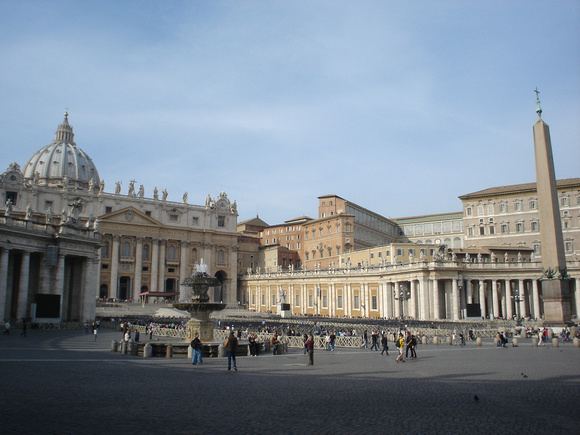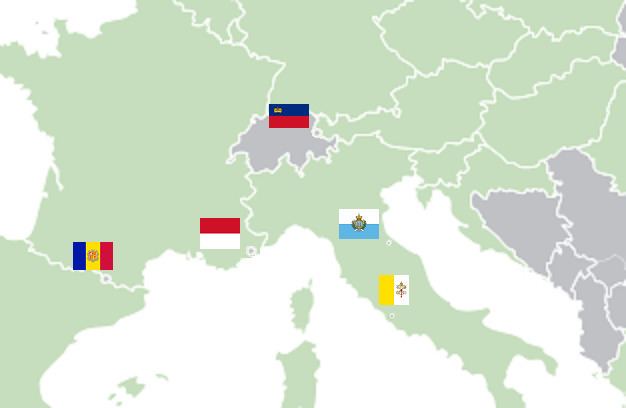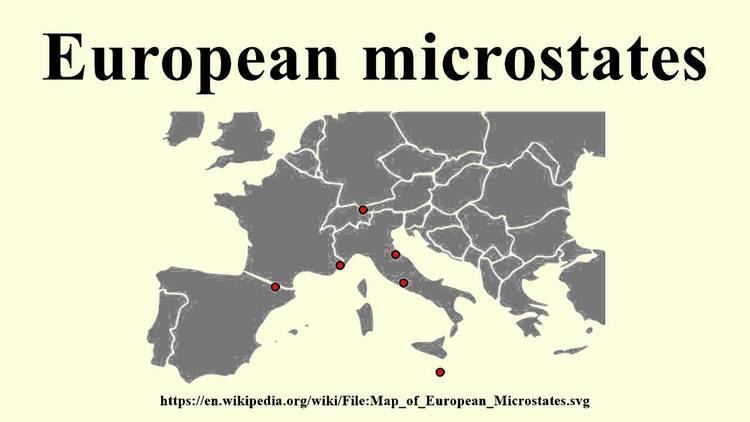 | ||
The European ministates are a set of very small sovereign states in Europe. Andorra, Liechtenstein, Malta, Monaco, San Marino, and the Vatican City are usually included, and are the six smallest states in Europe by area. Four of these states are monarchies (three principalities—Andorra, Liechtenstein, and Monaco—and one papacy, the Vatican City), with all these states tracing their status back to the first millennium or the early second millennium, except for Liechtenstein, created in the 17th century.
Contents
- Economic policies and relationship with the European Union
- Dependencies
- Sovereign Military Order of Malta
- Historical small territories
- Popular culture and sports
- References

Microstates are small independent states recognized by larger states, unlike micronations, which are only self-declared and not recognized. According to the qualitative definition suggested by Dumienski (2014), microstates can also be viewed as "modern protected states, i.e. sovereign states that have been able to unilaterally depute certain attributes of sovereignty to larger powers in exchange for benign protection of their political and economic viability against their geographic or demographic constraints." In line with this definition, only Andorra, Liechtenstein, San Marino, and Monaco qualify as "microstates" as only these states are sovereignties functioning in close, but voluntary, association with their respective larger neighbour(s). Luxembourg, which is significantly larger than the European microstates, nonetheless also shares some of these characteristics.

Some scholars dispute the status of Vatican City as a state, arguing that it does not meet the "traditional criteria of statehood" and that the "special status of the Vatican City is probably best regarded as a means of ensuring that the Pope can freely exercise his spiritual functions, and in this respect is loosely analogous to that of the headquarters of international organisations."

Economic policies and relationship with the European Union

The European microstates are all of limited size and population, and have limited natural resources. As a result, they have adopted special economic policies, typically involving low levels of taxation and few restrictions on external financial investment. Malta is a full member of the European Union, while the other five European microstates have obtained special relations with the European Union. Many of the microstates have also entered into a customs union with their larger neighbours to improve their economic situation (Vatican City and San Marino with Italy, Liechtenstein with Switzerland, Monaco with France). Most of them lack clearly marked borders; for example, Monaco forms a continuous metropolitan area with its neighboring French communes (the largest being Beausoleil) and has many streets running across or even along the border.
Dependencies

While the microstates have sovereignty over their own territory, there are also a number of small autonomous territories, which despite having (in almost all cases) their own independent government, executive branch, legislature, judiciary, police, and other trappings of independence, are nonetheless under the sovereignty of another state or monarch.

Sovereign Military Order of Malta
The Sovereign Military Order of Malta is a Catholic order that is a traditional example of a sovereign entity under international law other than a state.
Unlike the Holy See, which is sovereign over the Vatican City, the Order has no territory. However, its headquarters, located in Palazzo Malta and Villa Malta, are granted extraterritoriality by Italy, and the same status is recognized by Malta to its historical headquarters, located in Fort St Angelo. The Order is the direct successor to the medieval Knights Hospitaller, also known as the Knights of Malta, and today operates as a largely charitable and ceremonial organization.
It has permanent observer status at the United Nations and has full diplomatic relations, including embassies, with 100 states and it is in more informal relationships with five others. It issues its own stamps, coins, passports, and license plates, and has its own military.
Historical small territories
The wars of the French Revolution and the Napoleonic Wars caused the European map to be redrawn several times. A number of short-lived client republics were created, and the fall of the Holy Roman Empire gave sovereignty to each of its many surviving component states. The situation was not stabilized until after the Congress of Vienna in 1815. Following World War I and World War II a number of territories gained temporary status as international zones, protectorates or occupied territories. A few of them are mentioned here:
Popular culture and sports
A 1955 novel called The Mouse That Roared by Irish-American writer Leonard Wibberley features an imaginary European microstate called the Duchy of Grand Fenwick. The novel was later adapted to a play and film.
Some of the European microstates are members of the Games of the Small States of Europe (GSSE); several of the island dependencies compete in the Island Games, alongside several other island dependencies from elsewhere in the world.
